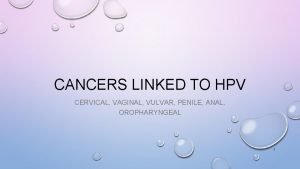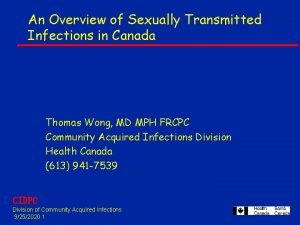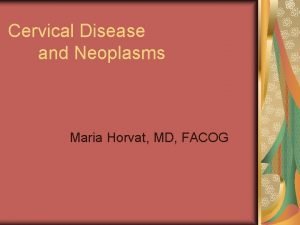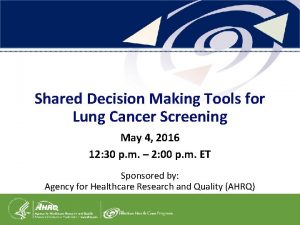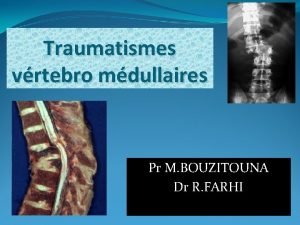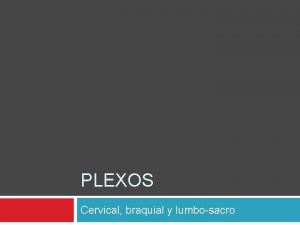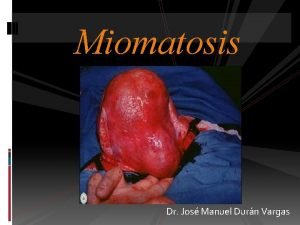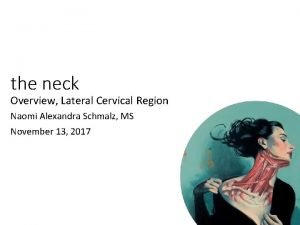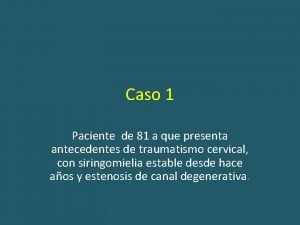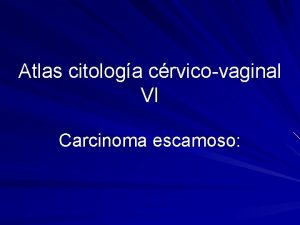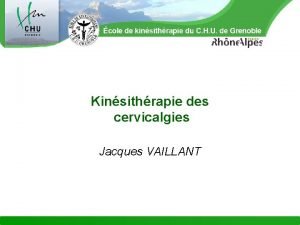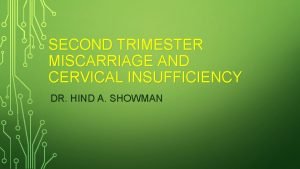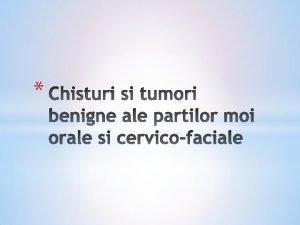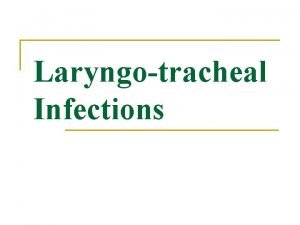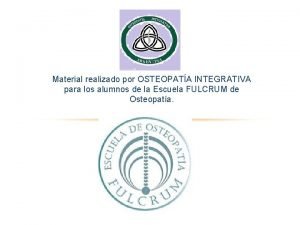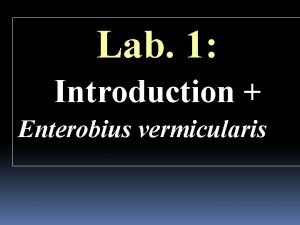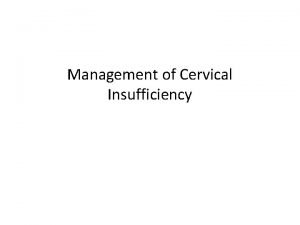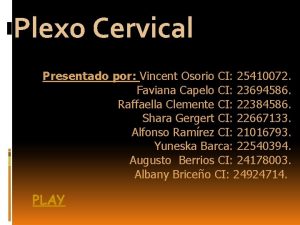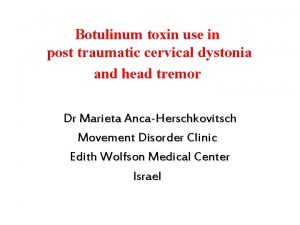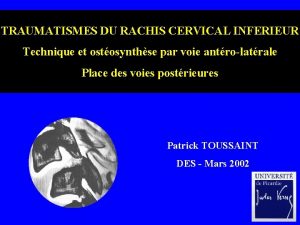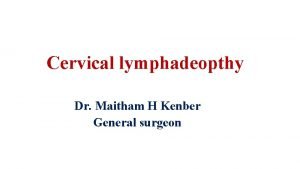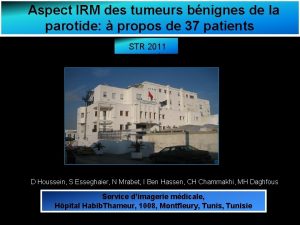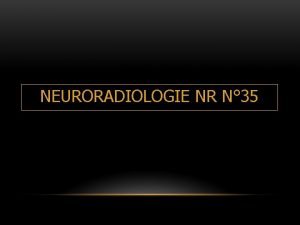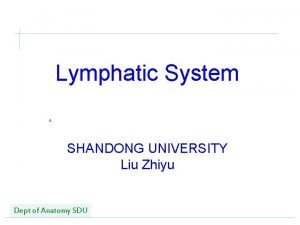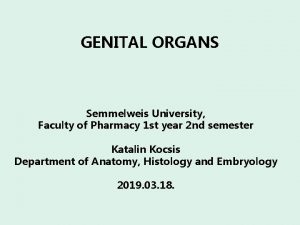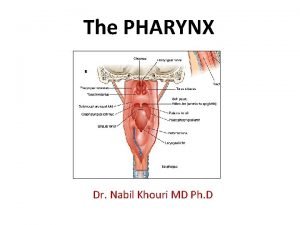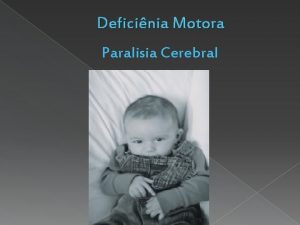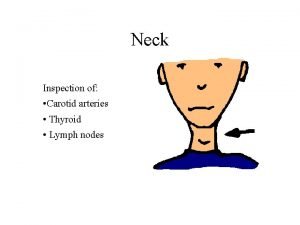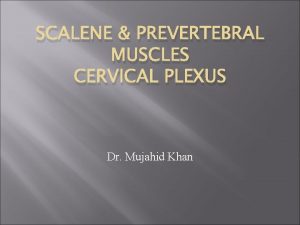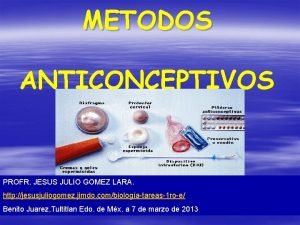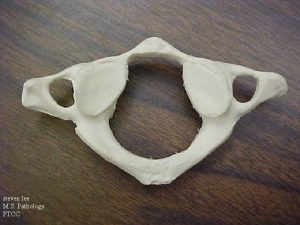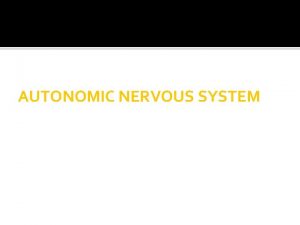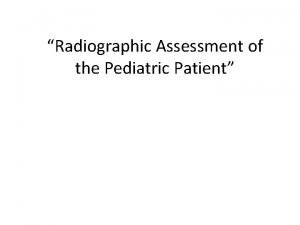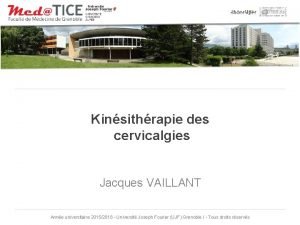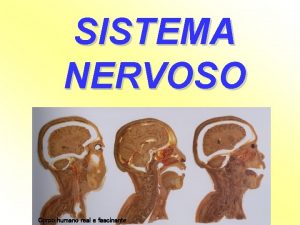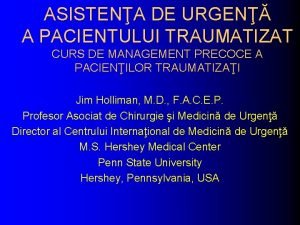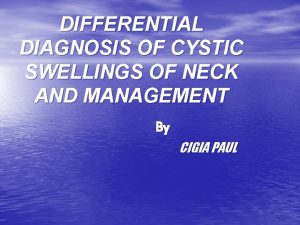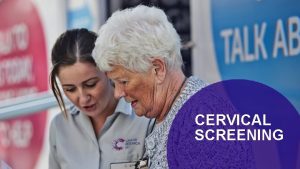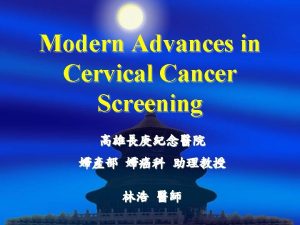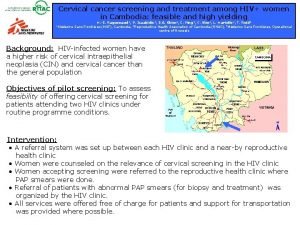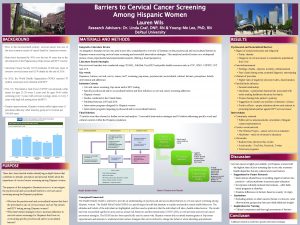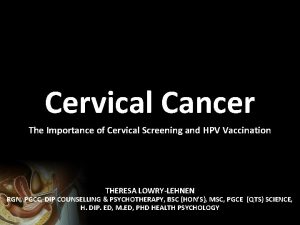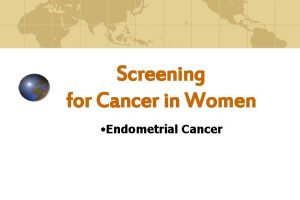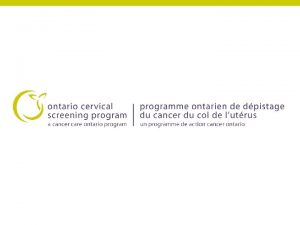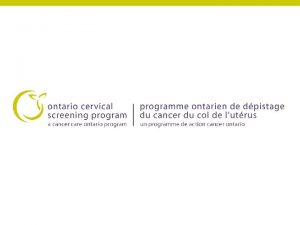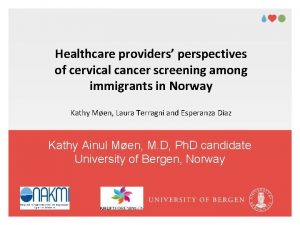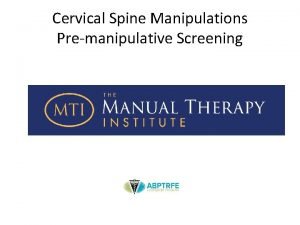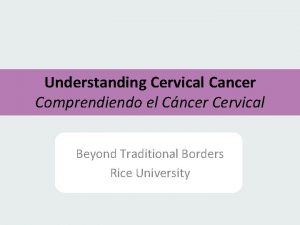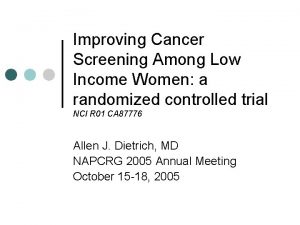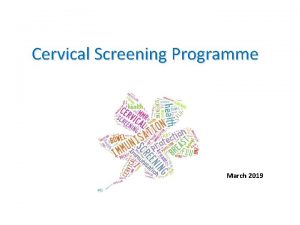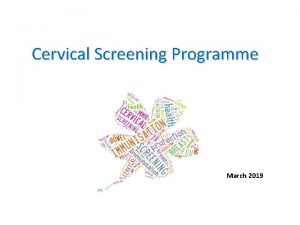AWARENESS OF CERVICAL CANCER SCREENING AMONG WOMEN UTILIZING











































































- Slides: 75

AWARENESS OF CERVICAL CANCER SCREENING AMONG WOMEN UTILIZING MATERNAL AND CHILD SERVICES IN FEDERAL MEDICAL CENTRE, YENAGOA, BAYELSA STATE. Presented BY Esther O. Famutimi RN, M. Sc(N), FWACN Ikoko Spiff, Ibirimokuma RN, RNT

Background 1 • One of the major public health challenges of 21 st Century is the rising global incidence of cervical cancer particularly in developing countries where over 190, 000 cases of death among women are recorded every year. (Babata and Abiola, 2010) • Cancer invading women is more on breast and cervix in Africa particularly Nigeria. The screening guide is a guide that contain test to detect early signs of breast and cervical cancer in women.

More so, that……. . • Cervical cancer is the second commonest and greatest killer cancer among women in developing countries like Nigeria. • This disease is characterized by uncontrolled and unregulated growth of cells with high propensity of invading or spreading to other parts of the body.

Reported risk factors: • • • Human papilloma virus infection Smoking Immunosuppression. Chlamydia infection A diet low in fruits and vegetables Long-term use of oral contraceptives (birth control pills) Having multiple full-term pregnancies Being younger than 17 at your first full-term pregnancy Poverty Being overweight Diethylstilbestrol (DES) Family history of cervical cancer

Against this background…… • The best way to fight cancer is to avoid its development by controlling the known risk factors. • Determining the cervical risks groups in a society, monitoring these groups and making screening programs widespread, is important for early diagnosis and treatment. • Innovation are therefore urgently needed to address the burden of cancer by creating more awareness on pre–cancer screening.

The problem 1 • By the year 2020 about 24. 6 million people will live with cancer worldwide; • Approximately 12. 5%of all death will be attributable to cancer. • 16 million new cases will be diagnosed per annum with 70% from developing countries such as Nigeria. (WHO, 2005)

The problem II • Despite progress in the health sciences and the development of methods for early diagnosis and treatment, cervical cancer contributes to morbidity and mortality globally. • It has been reported that the high morbidity and mortality rate of CC can be reduced through creation of awareness and screening practices such as pap smear, particularly in developing countries where the increase in multiples(Okobia 2008)

The problem III • For early diagnosis and treatment programmes of any malignancy to be effective , the general public must be aware of the diseases and its impact (Schulman, Kirby and Fitzpatrick, 2008 ) • Nurses play an important role in providing counseling for risk assessment, psychosocial support, health protection and cancer risk management(Karayurt and Zorukos 2008).

so what? • It is maintained that studies on this issue will contribute to raising awareness levels in healthcare providers and make a significant contribution to women’s health world wide. • Hence the for assessing awareness of precancer screening among women utilizing Maternal and Child services in Yenogoa, Balyesa state Nigeria.

General Objectives The overall aim of this study is to assess awareness of pre-cancer screening among women utilizing maternal and child services in Federal Medical Centre, Yenagoa, Bayelsa. The specific objectives To evaluate mothers’ level of awareness on cervical cancer screening. To examine mothers’ various sources of information on cervical cancer screening. To assess mothers’ knowledge of cervical-cancer screening To determine factors influencing mothers’ practice of cervical cancers screening.

Hypotheses • No association between participants’ level of knowledge of cervical cancer screening and their of education. • No association between participants’ marital status and their awareness of cervical cancer screening • No association between participants‘ practice of cervical cancer Screening and their awareness of CC screening.

Literature Review • • • Introduction Epidemiology of cervical cancer Incidence of Cervical Cancer Risk factors for cervical cancer Cervical cancer screening Screening benefits/barriers Cervical cancer knowledge Cervical cancers awareness Factors influencing practice of cervical cancer Conceptual framework for the study

Methods Design Descriptive cross sectional design was adopted for the study. Settings Ante natal clinic, lying-in ward, children welfare clinic and family planning clinic of FMC Yenogoa, Balyesa state

Sample size determination • Using Yare Yamme Formular to determine samples size • n= N • 1 + N (e 2) • Where N = Total Population • n = Sample size • e = 0. 05 • n= 192 • 1 + 192 (0. 052) • n= 192 • 1 + 192 x 0. 0025 • n= 192 • 1 +0. 48 • n = 192 • 1. 48 • n = 128. 7 • ≈ 129

• Sample size determination cont’d • Attrition rate of 10% was consider suitable for the study. i. e 10% of 129=12. 9 Approximately 13 13+ 129= 142 Therefore , this informed the researchers’ knowledge of utilizing 142 questionnaire for the study. Meanwhile at; antenatal clinic 67 per week ; Lying-in ward= 70 perweek children welfare clinic =30 perweek and family planning clinic=25 perweek

Sample size determination cont’d • Total =67+70+30+25= 192 • Source: record of utilization of maternal and child services in FMC Yenogoa. Ante natal : 67/192 x 142= 49. 5 approx. 50 Lying in ward : 70/192 x 142=51. 7 approx. 52 Children welfare clinic: 30/192 x 142=22. 1=22 Family planning 25/192 x 142=18. 4= 18 Hence 50+52+22+18=142

• Sampling technique • Systematic sampling technique was utilized for the study. • Inclusion criteria • Mothers utilizing maternal and child services of FMC Yenogoa irrespective of their age. • Instrument • The instrument for data collection consist of structured questionnaire divided into six sections.

Ethical Consideration • The study protocol was examined by the appropriate ethics committee and ethical approval was obtained from the hospital. Ethical Review Board. • Study was conducted in accordance with ethical standards laid down in the 1964 Declaration of Helsinki. • Informed consent was obtained from individual respondent before administration of the study instrument. • Instrument was pre-coded and the information obtained was kept confidential and used for research purpose only.

Procedure for Data Collection • Base on the sample size calculation 142 questionnaires were administered to the participants with the assistance of a research assistant. The data collection spanned through a period of 4 weeks.

Data analysis procedure • Data generated was edited, coded analyzed using SPSS version 20. • Findings from the study were presented in percentages, frequency tables, and testing of hypotheses were done using chi-square analysis with the level of significance set at 5%. (0. 05)

RESULT Table 4. 1: SOCIO-DEMOGRAPHIC CHARACTERISTICS OF RESPODENTS VARIABLE FREQ. n =134 Age(years) 18 -25 17 26 -30 20 31 -35 21 36 -40 47 41 -45 9 Marital status Married 74 Single 48 Divorced 10 Widowed 2 PERCENT 14. 9 15. 7 35. 1 12. 7 21. 6 55. 2 35. 8 7. 5 1. 5

Educational qualification No formal education Primary education Secondary education Tertiary education 2 8 31 93 1. 5 6. 0 23. 1 69. 4 Religion Christianity Islam Traditional 110 8 16 82. 1 6. 0 11. 9 Ethnicity Yoruba Igbo Hausa Igala 19 17 8 1 14. 2 12. 7 6. 0 0. 7

• Mothers awareness of CC screening 15, 8 Yes No 84, 2

• Mothers’ various sources of information on CC screening. 15, 2 40, 2 Healthworker media 20, 5 friends/relative posters/fliers 24, 1

• Knowledge of CC screening among mothers 90 80 70 60 Series 1 50 40 30 20 10 0 Good knowledge Poor knowledge

Pain associated with procedure Attitude of health workers Financial constraint Lack of time Religious/cultural belief 0 10 20 30 40 50 60 70

WHEN LAST CERVICAL SCREENING WAS DONE AMONG MOTHER 60 50 40 Series 1 30 20 10 0 Last 1 years Last 2 years Last 3 -4 years Last 5 years

Hypothesis Testing • There is no significant relationship between respondents level of education and their knowledge of CC screening. • The hypothesis shows relationship between respondent’s level of education and their knowledge. • P value (0. 05) , x 2= 1. 54, df=3, P value=0. 67. therefore the null hypothesis was not rejected.

Hypothesis • There is no relationship between marital status of respondents to practice of cervical cancer screening • The chi square analysis generated shows relationship between marital status of respondents and their CC screening. • The p value is ( > 0. 05), x 2= 7. 6, df= 9, p value 0. 57. Therefore the null hypothesis is hereby rejected.

Summary of Findings • Findings of this study revealed that the age range of respondents was between 18 to 45 years with 36 -40 years being the modal age group. • The awareness level on pre-cancer screening was relatively high (84. 2%) among the respondents as compared with their knowledge level about pre- cancer screening (64. 2%). • Although, awareness through health workers accounts for 42. 0% while media, friends/families and fliers/posters was indicated by 24. 1%, 20. 5% and 15. 2% respectively.

Summary cont’d • The study further revealed religious/cultural belief system was a major factor hindering respondents’ involvement and participation in pre-cancer screening as this was largely represented by 65. 7%. • Following this was lack of time (63. 4%), financial constraint (60. 5%, attitude of health workers (58. 9%) and pain associated with procedure (53. 4%) correspondingly.

• Summary cont’d • Among the hypotheses generated and tested for this study was the association between respondents’ level of education and their knowledge of pre cancer screening and association between respondents’ marital status and awareness of pre cancer screening which yielded 0. 67 and 0. 57 with chi square analysis respectively.

Conclusion • The study concludes that respondents’ level of knowledge could not commensurate with their level of awareness about pre-cancer screening. • And since health workers has been identified as a major informative factor on pre cervical screening, more efforts should be invigorated by the government to ensure that health workers are adequately equipped and empowered so that required and relevant information are disseminated appropriately to the populace on the subject matter.

Therefore ……. . • Nurses should consistently inform, communicate and educate clients accurately, comprehensively and intensively about cancer prevention as this will enhance clients’ compliance with clients control measures.

Thank you for listening








































 Hpv cervical cancer
Hpv cervical cancer National breast and cervical cancer early detection program
National breast and cervical cancer early detection program Hpv cervical cancer
Hpv cervical cancer National breast and cervical cancer early detection program
National breast and cervical cancer early detection program Cervical cancer hcp
Cervical cancer hcp Stage 4 cervical cancer
Stage 4 cervical cancer Lung cancer screening shared decision making tool
Lung cancer screening shared decision making tool Tuning out dull topics
Tuning out dull topics Compression tackle
Compression tackle Privacy awareness and hipaa awareness training cvs
Privacy awareness and hipaa awareness training cvs Entorse cervical
Entorse cervical Ejercicios desaconsejados para la columna vertebral
Ejercicios desaconsejados para la columna vertebral Primitive pharynx
Primitive pharynx Plexo cervical
Plexo cervical Metrorragia
Metrorragia Neck lymph nodes levels
Neck lymph nodes levels Sirinx cervical
Sirinx cervical Oesophagus
Oesophagus Atlas de citologia cervical
Atlas de citologia cervical Renforcement rachis cervical
Renforcement rachis cervical Sacro verticalizado
Sacro verticalizado Safe days chart
Safe days chart Referred back pain chart
Referred back pain chart Cervical circulage
Cervical circulage Central incisor
Central incisor Ranula sublinguala tratament
Ranula sublinguala tratament Infdee
Infdee Cervical spine reflexology
Cervical spine reflexology Cervical
Cervical Odontoclasia meaning
Odontoclasia meaning Aponeurosis cervical superficial
Aponeurosis cervical superficial Palmer diversified cervical rotary break
Palmer diversified cervical rotary break Intumescencia cervical
Intumescencia cervical Female ascaris worm
Female ascaris worm Thyrocervical trunk
Thyrocervical trunk Cervix
Cervix Shoulder extension
Shoulder extension Restricted cervical injection embalming
Restricted cervical injection embalming Vena yugular interna
Vena yugular interna Peripheral nerves
Peripheral nerves Parede torácica
Parede torácica Post-traumatic cervical dystonia
Post-traumatic cervical dystonia Entorse cervical
Entorse cervical Posterior cervical lymph nodes
Posterior cervical lymph nodes Arytenoid muscle
Arytenoid muscle Tumeur warthin
Tumeur warthin Reflejos cervicales
Reflejos cervicales Cavernome medullaire
Cavernome medullaire Lymphatic system
Lymphatic system Uterine axis
Uterine axis Constrictor muscles of pharynx
Constrictor muscles of pharynx Cervical enamel projection
Cervical enamel projection Coccygeal spinal nerves
Coccygeal spinal nerves Reflexo tonico cervical simetrico
Reflexo tonico cervical simetrico Carotid node
Carotid node Plexus cervicalis
Plexus cervicalis Moco cervical ovulacion
Moco cervical ovulacion Normal cervical length
Normal cervical length Atlas cervical vertebrae
Atlas cervical vertebrae Endoflagellum
Endoflagellum Gj mount classification of caries
Gj mount classification of caries Cervical ectropion
Cervical ectropion Discogenic low back pain
Discogenic low back pain Raw egg white cervical mucus
Raw egg white cervical mucus Gepants
Gepants Cervical sympathetic
Cervical sympathetic Cervical and brachial plexus
Cervical and brachial plexus Cervical burnout
Cervical burnout Renforcement rachis cervical
Renforcement rachis cervical Pulmonary ligament
Pulmonary ligament Onde ocorre a decussação das piramides
Onde ocorre a decussação das piramides Cervical sample taker database norfolk
Cervical sample taker database norfolk Ectocervix
Ectocervix Contuzie dex
Contuzie dex Guler cervical
Guler cervical Subhyoid bursal cyst
Subhyoid bursal cyst
